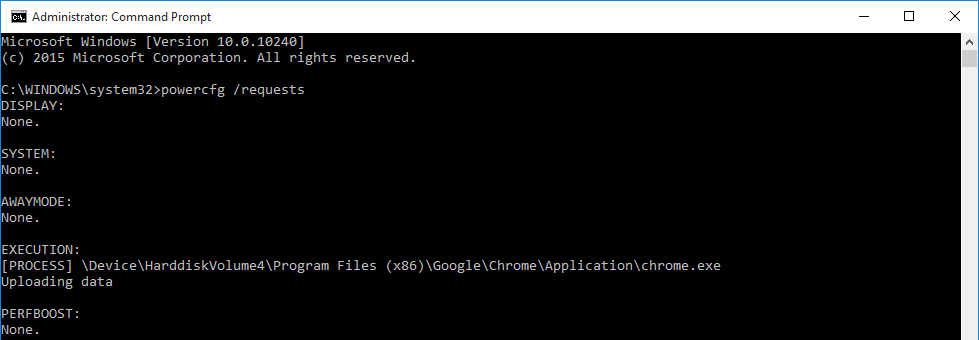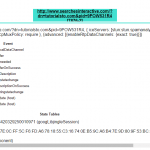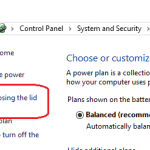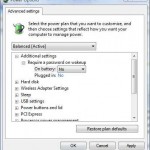The Chrome prevents and stops Windows system from going into sleep, stand-by or hibernation because one or more of the web pages (tabs), extensions or apps is using the system resources, effectively telling Windows that Chrome is still actively performing some tasks, and hence do not put computer into sleep, stand-by or hibernation mode.
You can check if Chrome is using any power requests by opening a Command Prompt with Administrator privileges, and then run the following command:
powercfg /requests
The output looks like below:
DISPLAY: None. SYSTEM: None. AWAYMODE: None. EXECUTION: [PROCESS] \Device\HarddiskVolume4\Program Files (x86)\Google\Chrome\Application\chrome.exe Uploading data PERFBOOST: None.
Or if you’re playing video or audio, such as on YouTube, web pages loading with Flash ads, video ads and audio ads, the output of the command looks similar to below instead:
DISPLAY: [PROCESS] \Device\HarddiskVolume4\Program Files (x86)\Google\Chrome\Application\chrome.exe Playing video SYSTEM: [DRIVER] Realtek High Definition Audio (HDAUDIO\FUNC_01&VEN_10EC&DEV_0269&SUBSYS_10250727&REV_1001\4&c387b3d&0&0001) An audio stream is currently in use. AWAYMODE: None. EXECUTION: [PROCESS] \Device\HarddiskVolume4\Program Files (x86)\Google\Chrome\Application\chrome.exe Playing audio PERFBOOST: None.
Instead of exiting and closing the whole Chrome web browser, you can try to identify the culprit which is running process that is making the power requests, preventing the system from sleeping, standing-by or hibernating.
Workaround 1: Close the Tabs Which Are Playing Video and/or Audio
If you’re seeing the results that Chrome is playing audio and/or is playing video, identify the web pages that are playing the audio and/or video, and then close the tabs to resolve the Windows won’t go to sleep, standby or hibernate when Chrome is running issue. Do pay attention to video ads, audio ads, Flash ads and other multimedia advertising that can play video and sound. Normally, a speaker icon is shown on the tab when the tab is playing an audio stream, helping you to identify it. Such websites include YouTube, Netflix and etc.
Workaround 2: Close the Tabs That Are Performing Background Process
If you’re seeing Chrome is uploading data as one of the power requests on execution category, then the identification of the causing culprit is much harder. Any extensions, apps or tabs in the Chrome may prevent the Windows from sleeping, standing-by or hibernating.
To troubleshoot it, disable extensions, plugins, apps, and tabs one by one, until the power requests made by Chrome is gone.
Some common Chrome apps, extensions, plugins or websites that may cause Chrome to hold power requests indefinitely including Outlook.com, Adobe Flash Player, Yahoo! Mail, AwesomeScreenshot, Zeverator, Google Play Music, Motorola Connect, Adsblock Dropbox synchronization, Remember The Milk (for Gmail) and many more which normally involves background processes or updates.
Workaround 3: Disable JavaScript
If you have too many tabs opened, disable JavaScript may be they way to stop any background processes, uploads, downloads, tasks, updates, audio and video from running unbeknownst. To do so, open Chrome menu, go to Settings -> Show advanced settings -> Content settings. Select the radio button for Do not allow any site to run JavaScript. Doing so also have the added advantage of reducing system resources consumed by Chrome.
Note that you need to reload all open tabs after turning off the JavaScript support in Chrome. You can always re-enable the JavaScript and then refresh the web pages when you need to view the web pages normally.
Workaround 4: Override Chrome Power Requests
Windows provides option that allows users to set a power request override for a particular process, service, or driver. We can set a power request override for Chrome, so that any power request made by Chrome will not stop Windows from going into low power sleep, standby or hibernate state.
To do so, open a Command Prompt with Administrator privileges, and execute the following command:
powercfg /requestsoverride PROCESS chrome.exe AWAYMODE DISPLAY SYSTEM
powercfg /requestsoverride PROCESS chrome.exe
To check current list of power request overrides, run the following command:
powercfg /requestsoverride
Workaround 5: Group Policy to Disallow Apps to Prevent Automatic Sleep or Hibernate
This trick will apply on all programs and applications, not just Chrome.
- Open Local Group Policy Editor (GPedit.msc).
- Go to Computer Configuration -> Administrative Templates -> System -> Power Management -> Sleep Settings.
- Set the following two settings to Disabled:
Allow Applications to Prevent Automatic Sleep (On Battery)
Allow Applications to Prevent Automatic Sleep (Plugged In)







